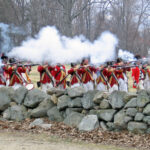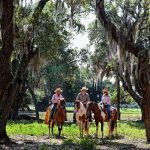Bethlehem, NH Christmas Trees | Yankee Classic
For many years and many reasons, travelers have been drawn to Bethlehem, New Hampshire. This quiet vale at the edge of the White Mountain National Forest once boasted dozens of resort hotels. Its pure mountain air gave rise to the National Hay Fever Relief Association. Signs proclaim it the poetry capital of the state. These […]

Coffee By Design | Portland, Maine
Photo Credit : Katherine Keenan
For many years and many reasons, travelers have been drawn to Bethlehem, New Hampshire. This quiet vale at the edge of the White Mountain National Forest once boasted dozens of resort hotels. Its pure mountain air gave rise to the National Hay Fever Relief Association. Signs proclaim it the poetry capital of the state. These days, in December, Bethlehem is New Hampshire’s Life-size “snow village.” The town, full of Yuletide spirit, is not only a source of distinctive postmarks for holiday mail; it is also the source for a perfect Christmas tree.
I like a freshly cut tree. I know it might sound politically incorrect, especially to my friends and kin who decorate houseplants in order to spare the poor pines. I’m probably missing the point, but a beribboned ficus looks just plain silly. I want my tree fresh — needle shedding and all. The pungent smell and springy feel of real evergreenery is why the Romans brought the outdoors indoors in the first place.
At the Rocks Christmas Tree Farm in Bethlehem even my most ecologically minded friends can enjoy (free of guilt) a real balsam fir. These are true giving trees. The dollars generated by the harvest help preserve the 1400-acre Rocks Estate and fund conservation education. The Rocks is the northern headquarters of the Society for Protection of New Hampshire Forests, the state’s oldest and most active conservation association.
On the day we set out on our Christmas-tree quest, the passage through Franconia Notch was an adventure. Seems someone had drawn a white line just below Cannon Mountain. To the south the day was gray and rainy. Pure November. To the north, it was full-blown winter — pelting snow and biting wind. Nothing like a good snowstorm to ignite the holiday spirit! We were headed north to Littleton and its Beal House Inn. The Beal House, along with dozens of other hotels, motels, and inns in the area, offers tree-and-Iodging packages. Travelers stay a night or two, eat lots of good food, work it off hunting the Rocks plantation for the perfect Tannenbaum, and head home with visions of tree trimmings in their heads.
Built in 1833, the Victorian Beal House is sumptuous but not stuffy. When we arrived the weekend after Thanksgiving, it was adorned with lights, garlands, golden horns, and angels. Giant plaid ribbons wrapped windows and doorways. We sipped mulled cider and nibbled butter cookies beside a glowing fire while checking in. The fullest tree we’d ever seen anchored a corner of the sitting room. “It’s from the Rocks,” Michael McGuinn, the innkeeper, told us.
We settled into our room with a four-poster canopy bed, plump down comforter, and pretty antique furniture. The wicked weather had triggered our appetites, so we headed downstairs where dinner is served in two romantic dining rooms. Mike’s wife, Pat, is the chef. We tried the wild mushroom bisque, filet mignon with chipotle pepper oil and Gorgonzola sauce, and roasted vegetables, and for dessert we shared a tower of chocolate mousse couched in a dark-chocolate crunch. After that delicious feast we weren’t hungry for the inn’s full breakfast come morning, but we caved in when Michael pressed upon us Pat’s baked apple. Steaming and stuffed with raisins, it was served in a pool of cream, maple syrup, and spices.
We arrived at the Rocks in time to catch the first horse-drawn hay wagon out to the tree plantation. The gray skies were still with us, but low mountains softened the horizon, and our guide pointed out where Mount Washington lurked behind clouds. Our wagon carried flatlanders and locals. We could tell the latter by their sensible boots and hats, and the former by their lack thereof. Even though it’s only two hours from Boston, Bethlehem is in the heart of the North Country. With blankets tucked on our laps everyone rode in warmth.
The stone walls lacing the Rocks’s hill sides are history’s handwriting. Originally the farm was the summer home of John J. Glessner and family. Glessner was one of the founders of International Harvester, farm equipment manufacturers. After removing all the boulders from the estate “with sweat and profanity and with oxen and with great skill,” he tested progressive farm machinery on this land. He raised Jerseys, pigs, and sheep, and though he didn’t have a tree farm, he harvested a wild Christmas tree each year to take back to his Chicago home.
Glessner was one of the first members of the Forest Society. He and other summer residents banded together to protect the landscape from the ravages of unchecked lumbering at the turn of the century. Their efforts led to the creation of the 768,000-acre White Mountain National Forest in 1911, the first national forest in the country. In 1979 the Glessner family donated most of the estate to the society.
The hay wagon slowed to a stop. We tramped along the straight rows of trees, proud and puffed up as new recruits. Five inches of snow crunched underfoot. All around us were the smells of Christmas: pine trees, new snow, horses, and wet wool.
We walked the rows and thought about how much future joy unfolded before us. Some 55,000 Christmas trees grow here at one time — all pushing toward that bright Christmas morning when they hold magic in their branches.
Our tree was near the end of a row, full-bodied and about 6Y, feet tall. We tagged it, cut it down with the bow saws provided, and dragged it to the end of the row. Volunteers pick up the trees and trailer them back to the main barn, where a contraption winds and twines them for car-top travel. We hopped the next hay wagon back to the barn.
Our lodging package included a wreath, too. The former electric plant behind the barn is stocked with fresh wreaths, tree stands, ornaments, and specialty trees. Sipping hot chocolate, we decided on the society’s “untraditional” Rocks wreath, decorated with cones, lotus pods, canella berries, and statice, and topped with a blue velveteen bow.
We set out on the mile-long Christmas Tree Trail and learned how the trees are cared for. Seedlings are four to five years old when they are first planted. They are fertilized in early spring, then in summer are sheared by hand into their conical shape. An average six-foot tree is over ten years old by the time it reaches your living room! Bird perches are sprinkled throughout the plantation to protect the fragile treetops. Even a red-winged blackbird could bend or break the top “leader” on a maturing tree. Kindergartners in Bethlehem plant a seedling and care for it over six seasons before harvesting it when they reach the sixth grade.
All that hiking and fresh air made us hungry again. We loaded our tree and headed to the village to mail Christmas cards and have a bite. Night was falling when we finally drove out of the mountains. I turned back to look at the peaks fading against the sky. The first stars were twinkling, and sure enough, the brightest one of all hung just over Bethlehem.







